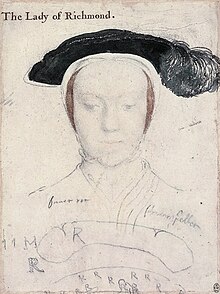Mary FitzRoy, Duchess of Richmond and Somerset
| Lady Mary Howard | |
|---|---|
| Duchess of Richmond and Somerset | |
 Sketch of the Duchess of Richmond by Hans Holbein the Younger. | |
| Spouse | Henry FitzRoy, 1st Duke of Richmond and Somerset |
| House | House of Tudor |
| Father | Thomas Howard, 3rd Duke of Norfolk |
| Mother | Lady Elizabeth Stafford |
Mary FitzRoy, Duchess of Richmond and Somerset (1519- 7 December 1557), formerly Lady Mary Howard, was an English duchess of the Tudor period.
Biography
Mary Fitzroy was the second daughter of Thomas Howard, 3rd Duke of Norfolk: a member of the ambitious Howard Family. At the time of her birth, her father was the second most senior noble in the English peerage; her maternal grandfather Edward Stafford, 3rd Duke of Buckingham the most senior. After Buckingham's execution in 1521, her father was the only duke in the kingdom. This changed in 1525, when Henry VIII elevated Henry FitzRoy, his six year-old illegitimate son by Elizabeth Blount, to the Dukedom of Richmond and Somerset. When in 1529 Thomas Wolsey, who was charged with Fitzroy's care, fell from grace the mantle passed to Thomas Howard. At the same time the idea arose, allegedly from either the King or Anne Boleyn[1], that Fitzroy should marry his daughter. Four years later, in November 1533, negotiations were completed and Mary, now aged fourteen or fifteen, and Fitzroy, himself just fifteen, were married.
The match was a triumph for the Boleyn family as Mary was a former member of the Queen's household, and a staunch advocate of reform. It was also a very advantageous match for Mary as with no legitimate male heir to the throne the Duke was seen at the time as a likely future King. However, the marriage was not to last as FitzRoy died of consumption within three years. He had barely turned seventeen.
Fearful that too much sexual activity had hastened his elder brother Arthur's death, the King had ordered the couple not to consummate their marriage. As a result the Duchess was not allowed to keep many of the lands which would normally have been her entitlement as widow: the King insisted without the consummation it was not a true marriage. She remained at court, closely associated with the King's niece, Margaret Douglas, and one of his mistresses, Mary Shelton. When Catherine Howard fell from grace, the Duchess and her entire family were arrested and briefly imprisoned in the Tower of London. In both 1538 and 1546 her father petitioned[2] for her to be married to Thomas Seymour. The King gave his approval for the match but her brother, Henry, Earl of Surrey objected strongly, as did the Duchess herself, and the marriage did not take place. Surrey then suggested that the Duchess should seduce the aged King, her father-in-law, and become his mistress, to "wield as much influence on him as Madame d'Etampes doth about the French King". The Duchess, outraged, said she would "cut her own throat" rather than "consent to such villainy".[3] She and her brother fell out, and she later laid testimony against Surrey that helped lead to his trial and execution for treason.
The Duchess never remarried and her presence at court dwindled not long after Henry VIII died in January 1547. She, knowing how merciless her family was about power, and perhaps not wanting to be involved in another scandal, possibly chose to stay out of their plans in order to live a quiet life. She died in late 1557.
Further reading
- Beverley A. Murphy's 'Henry VIII's Lost Son'
- Kelly Hart's The Mistresses of Henry VIII
- Henry VIII's Last Victim: The Life and Times of Henry Howard, Earl of Surrey by Jessie Childs
- Henry Howard, the Poet Earl of Surrey: A Life by W.A. Sessions and David Starkey
Fictional portrayals
Though the Duchess has not been portrayed in any film or television program thus far, she has appeared in many books of noted historical fiction, most notably The Sixth Wife, in which she is a rival of Catherine Parr, and is used by her brother Surrey to try and become a "seventh wife" of the King despite her protests. As in history's account, her character mainly falls into the background toward the end of the novel after the king has died.
External links
- A portrait of the Duchess titled "Lady of Richmond" was sketched by Hans Holbein
